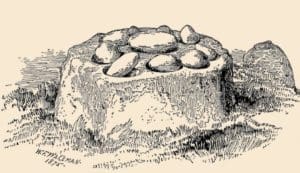The Green Man: Unveiling the Symbolism and Mythology

Updated On: April 11, 2024 by Raghda Elsabbagh
Ever wonder why images of an uncanny figure crafted from leaves and vines keep cropping up in ancient art and architecture? You’re not alone, mate. The same enigma led us down a path of discovery about ‘The Green Man’.
This symbolic character weaves its way through many cultures and traditions. It’s often associated with Celtic folklore and symbolises rebirth — an intriguing contradiction to its slightly unnerving portrayal.
So put the kettle on and settle in because as we delve deeper into this post, you’ll unveil the captivating mythology behind The Green Man, like peeling back layers of a mystical onion.

Table of Contents
Origin and Evolution of the Green Man Symbol
The Green Man symbol has its origins in Celtic folklore and has evolved over time. While pinpointing his exact origins proves as elusive as catching a fleeting breeze, scholars believe he may have emerged from the depths of pre-Christian traditions.
The Green Man figure has been found in various cultures and mythologies, including Celtic, Norse, and Roman. It is believed to have connections to the natural world and is sometimes associated with the god Shiva. Throughout history, the Green Man has appeared in art, architecture, and literature as a symbolic representation of growth and renewal.
Intriguingly, the Green Man embodies the symbiotic relationship between humanity and the natural world. He is a testament to the reverence our ancestors held for the land, its cycles, and the eternal dance of life and death.
The Symbolism of the Green Man
The Green Man is often depicted with leaves, branches, or vines sprouting from his face, emphasizing his close association with plants and growth. In ancient times, people believed that by invoking the image of the Green Man, they could bring about abundance and fertility in their surroundings. This belief still resonates today for those who seek a deeper connection with nature and its regenerative powers.
At his core, the Green Man symbolises the eternal cycle of life, death, and rebirth. His leafy countenance speaks of fertility, growth, and the inexorable rhythm of the seasons. In every leaf, every tendril of the vine, we find echoes of ancient wisdom, reminding us of our interconnectedness with the natural world and fertility.
Association with Pagan Beliefs and Rituals
The mythology of the Green Man is deeply rooted in ancient pagan beliefs and rituals that date back centuries. In ancient times, people believed in the power of nature and worshipped natural forces. The Green Man symbolised fertility, growth, and the cycle of life. He was often associated with seasonal celebrations and harvest festivals. People would perform rituals to honour him and ask for blessings for their crops and livestock. The Green Man’s connection to pagan beliefs can still be seen today in folklore, myths, and traditions that celebrate the cyclical nature of life.
Exploring Variations and Interpretations

As we journey deeper into Celtic folklore, we discover a myriad of interpretations and stories of the Green Man figure. From the gnarled oaks of Ireland to the mist-shrouded hills of Scotland, each region infuses its own unique flavour into the mythos of the Green Man.
In folklore and stories, the Green Man figure is often portrayed as a mysterious and powerful being. People believed that encountering the Green Man could bring both blessings and curses.
Some portray him as a benevolent guardian of the wild places, protecting forests and woodlands from harm. Others perceive him as a trickster spirit, luring wanderers off the beaten path. In some tales, he is said to have the ability to manipulate plants and shape-shift into different forms. Yet, amidst these various interpretations, one constant remains: there’s a deep connection between humans and nature, emphasising the importance of respecting and preserving our natural environment.
Unveiling the Mystique of the Green Man’s Visage
Now, let’s explore the captivating characteristics of this timeless figure from Celtic folklore. Behold the Green Man, his countenance a mesmerising tapestry of nature’s bounty. His face is adorned with a verdant mane of leaves and tendrils; each intricate detail is a testament to the lush beauty of the natural world.
But what lies behind those leafy eyes? Some say they hold the wisdom of the ages, while others perceive a mischievous glint, hinting at the Green Man’s penchant for playful antics. Regardless of interpretation, one thing is certain: his presence is as invigorating as a breath of fresh forest air.
Variations Across Time and Space
As we journey deeper into the annals of Celtic art and folklore, we discover a kaleidoscope of interpretations of the Green Man figure. In some depictions, the Green Man appears serene and contemplative, a silent sentinel watching over the woodlands. In others, he is wild and untamed, his laughter echoing through the glens like the rustle of leaves in the wind. Yet, amidst this diversity, a common thread emerges: the Green Man’s connection to the vitality and fecundity of the natural world.
Interpreting the Enigmatic Expression
Ah, but what of the Green Man’s expression? Is it one of stoic contemplation, or does it betray a hint of mischief lurking beneath the surface? Perhaps it is a reflection of the observer’s own perceptions, inviting us to project our own emotions and experiences onto his leafy canvas.
Some see sorrow in his eyes, mourning the passing of seasons and the inevitability of change. Others find joy in his smile, a celebration of life’s boundless abundance and the promise of new beginnings. Whatever your interpretation, the Green Man’s expression invites us to ponder the mysteries of existence and our place within the grand tapestry of creation.
Mythological Stories and Legends
Now, let’s uncover the mythological stories and legends that enshroud the enigmatic Green Man.
The Legend of Jack-in-the-Green: A Dance of Seasons
Let us regale you with the tale of Jack-in-the-Green, a beloved figure from English folklore who embodies the spirit of spring’s awakening. As the winter frost begins to thaw and the first buds of green appear upon the trees, Jack emerges from the depths of the forest, clad in verdant splendour. With each step, he breathes new life into the world, coaxing the flowers to bloom and the birds to sing. Yet, as summer’s warmth gives way to autumn’s chill, Jack’s vibrant hues fade, and he retreats once more into the shadows, awaiting the cycle’s renewal.
The Green Knight: A Test of Courage and Honor
Ah, but no discussion of Green Man legends would be complete without mentioning the tale of the Green Knight, a figure of both challenge and revelation. In the Arthurian legend of Sir Gawain and the Green Knight, our valiant hero faces a formidable adversary in the form of a giant green warrior.
But beneath the Green Knight’s imposing exterior lies a test of courage and honour, as Sir Gawain must confront his own mortality and the frailty of human nature. Through trials of strength and virtue, he emerges not only victorious but enlightened; his spirit tempered like steel in the forge of adversity.
The Wild Hunt: A Thunderous Symphony of Nature’s Fury
And what of the Wild Hunt, that thunderous cavalcade of spirits and spectres that rides across the night sky? In some Celtic traditions, the Green Man is said to lead this spectral procession, his laughter echoing through the darkness like the call of the wild.
With each hoofbeat and crack of thunder, the Green Man and his spectral retinue herald the changing of the seasons, reminding mortals of the eternal dance of life and death. To glimpse the Wild Hunt is to witness the raw power of nature unleashed, a sight that both terrifies and exhilarates the soul.
Cultural Significance and Modern Interpretations
In this section, we’ll peel back the layers of tradition and innovation to reveal the verdant heart of this enigmatic guardian of the wild places.
Guardian of the Greenwood: A Symbol of Resilience and Renewal
In the tapestry of Celtic culture, the Green Man stands as a stalwart guardian of the Greenwood, a symbol of nature’s resilience and the eternal cycle of renewal. His leafy countenance whispers secrets of the earth’s bounty, reminding us of our interconnectedness with the land and its myriad inhabitants.
But his influence extends far beyond myth and legend. In modern times, he serves as a potent symbol of environmental stewardship and conservation, inspiring individuals and communities to protect and preserve the natural world for future generations.
Artistic Inspiration: From Ancient Carvings to Contemporary Creations
Ah, but the Green Man’s reach extends even further into the realms of art and creativity. From the ancient stone carvings of Celtic artisans to the vibrant canvases of modern painters, his leafy visage has served as a wellspring of inspiration for countless artists throughout the ages.
In literature, music, and film, the Green Man’s presence can be felt like a subtle undercurrent, weaving its way through the fabric of storytelling and imagination. His image adorns everything from book covers to album art, a testament to his enduring appeal and timeless allure.
Eco-Spiritual Perspectives: Finding Meaning in Nature’s Embrace
However, perhaps the most profound modern interpretations of the Green Man are found in the realms of eco-spirituality and green theology. For many, he is not merely a figure of myth and legend but a living embodiment of the divine within nature itself.
In this worldview, every leaf and blade of grass is infused with the spirit of the Green Man, reminding us of our sacred duty to act as stewards of the earth. Through rituals and ceremonies, individuals seek to rekindle their connection with the natural world, honouring the Green Man’s legacy and seeking guidance in their quest for harmony and balance.
In conclusion, the Green Man symbolises the cycle of life, death, and rebirth. It represents new growth and is associated with nature and fertility. The mythology surrounding the Green Man dates back thousands of years and is found in various cultures. This ancient symbol holds spiritual significance as a reminder of transformation and renewal in our lives. So, next time you see a depiction of the Green Man, remember its powerful symbolism and connection to the natural world.
FAQs
Where can you find images of the Green Man?
You may see the Green Man as a stone sculpture or decorative design in medieval churches. He often comes across as a face made from leaves and stems.
Is there any connection between the Green Man and reincarnation?
Yes! In ancient rituals and traditions, the Green Man symbolises the cycle of life, death, and rebirth, which can be seen as an image of reincarnation.
Does the Green Man hold relevance even now?
Of course! This mythical creature’s symbolic imagery remains relevant today in art, architectural themes of transformation, spirituality symbolism and more!
What does it mean when we see disfigured forms of the Green Man?
Disfigured forms might hint to his darker resonance with dictatorship over nature deities; however, it is mostly interpreted as a dramatic expression within folklore legends.






